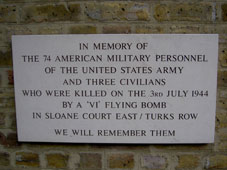“We Will Remember Them”
On July 3, 1944, a V-1 flying bomb launched by the Nazis decimated the 130th Chemical Processing Company of the United States Army while it was stationed at Sloane Court in South London.  The incident marked the greatest loss of life for American servicemen due to a V-1 bomb, or “buzz bomb,” attack.
The incident marked the greatest loss of life for American servicemen due to a V-1 bomb, or “buzz bomb,” attack.
Today, a plaque at the corner of Sloane Court East and Turk’s Row commemorates the destruction: “In memory of the 74 American military personnel of the United States Army and three civilians who were killed on the 3rd July 1944 by a ‘V1’ Flying Bomb in Sloane Court East. We will remember them.”
Putting the Pieces Together
Due to wartime censorship, very little information exists about this historical event. In 1944, the allies did not want the Germans to learn of the success of the attack, and they therefore did not publicize the bombing or allow the soldiers who survived to notify their relatives. But seventy years later, the bombing and the loss of life that resulted still haunt the soldiers who witnessed the attack.
There’s Samuel E. Hatch, whose stories to his grandchildren inspired this website. There’s Lois Baer, a veteran, and Bill Figg, a local, each of whom dedicated the two plaques that now memorialize the event. There’s Eric Stern, Jean Castles, and Edward Pols, who wrote down what they saw to memorialize the event for future generations.
But then there’s Theodore Booras. Booras, who switched chores with Hatch and died as a result of that fateful offer to help. Booras and Hatch had only arrived in London two months earlier. They would not be on the front lines. Instead, they were trained in dealing with the aftermath of a possible enemy attack using chemical warfare, as had occurred in World War I. But the bombing changed all that. Booras and 61 other servicemen from the 130th Chemical Processing Company would never return from the war.
A Quest to Remember
This website seeks to commemorate those who served by publicizing the details of the bombing, ensuring the preservation of the story of this tragic incident in the historical record.
Please take the time to explore this website. For a comprehensive history, read Ed’s Story. Or, to browse, begin with The Bombing: What Happened.
